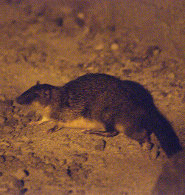 The Golden-bellied water rat (Hydromys chrysogaster) is another one of the many hidden gems within Australia's wildlife; commonly mistaken for the famed platypus due the fact that they inhabit many of the same waterways and bear a resemblance from a distance, golden-bellied water rats are just as unique and intriguing. Native to Australia, New Guinea, and their surrounding islands, the golden-bellied water rat is a crucial part of the ecosystem with roles as both predator and prey.
The Golden-bellied water rat (Hydromys chrysogaster) is another one of the many hidden gems within Australia's wildlife; commonly mistaken for the famed platypus due the fact that they inhabit many of the same waterways and bear a resemblance from a distance, golden-bellied water rats are just as unique and intriguing. Native to Australia, New Guinea, and their surrounding islands, the golden-bellied water rat is a crucial part of the ecosystem with roles as both predator and prey.The golden-bellied water rat is typically found along the shorelines of ponds, rivers, and lakes in burrows where a mother and pups will live or a single water rat will live alone. The mother weans her young quickly and within about 35 days the pups are fully independent. Golden-bellied water rat burrows are often found along coastlines as well, but they usually stay withing range of a fresh water source; the water rat's burrows commonly have multiple chambers and entrances, and seeking cover in the burrow is its only real defense mechanism against predators like birds of prey and snakes.
The golden-bellied water rat is brown to gray in color with a lighter brown or tan underbelly and a very distinctive broad-based tail that is tipped white. They typically grow to be around 24 inches (60cm) long and can weigh 30 ounces (850g) or more.
The golden-bellied water rat is perfectly suited to its environment with webbed toes on both feet, a long and slender snout, and a strong tail for agility in the water; these animals are said to resemble an otter when swimming and hunting more than a rat. The golden-bellied water rat also has the curious ability to tolerate polluted, clouded, and brackish waterways, giving them an advantage in habitat competition. The water rat is warm-blooded and therefore must contend with potentially dangerous cold spells, and they are also susceptible to hypothermia; another of their adaptations in the form of a layer of special insulating fat helps them combat the winter temperatures when they must still hunt in the frigid water.
The golden-bellied water rat is abundant and thriving and is considered a low risk as far as endangered species watch lists are concerned. Outside of being a great example of animal diversity and a key element in the food chain and ecosystem as a whole, the golden-bellied water rat may also hold potential breakthroughs in medical research due to its tolerance of toxins ingested internally, as with the cane toad, and toxins in the environment like polluted waters.
Picture of the Golden-bellied water rat by Mikeybear, licensed under the Creative Commons Attribution 3.0 Unported license.
The Golden-bellied water rat is listed as Least Concern (LR/lc), lowest risk. Does not qualify for a more at risk category. Widespread and abundant taxa are included in this category, on the IUCN Red List of Threatened Species
Namings for the goldenbellied water rat
A young / baby of a goldenbellied water rat is called a 'kitten, nestling, pinkie or pup'. The females are called 'doe' and males 'buck'. A goldenbellied water rat group is called a 'colony, horde, pack, plague or swarm'.Some facts about the
Golden-bellied water rat
Adult weight : 0.85 kg (1.87 lbs)
Maximum longevity : 7 years
Female maturity :163 days
Male maturity : 135 days
Gestation : 36 days
Weaning : 30 days
Litter size : 4
Litters per year : 2
Interval between litters : 60 days
Weight at birth : 0.024 kg (0.0528 lbs)
Weight at weaning : 0.15 kg (0.33 lbs)
Basal metabolic rate : 3 W
Body mass : 0.9 kg (1.98 lbs)
Temperature : 36.85 °C (98.33 °F)

Custom Search